Table of Contents
Rainbow Shark Overview
The rainbow shark, or the Epalzeorhynchos frenatum, is not your typical image of a shark. It’s actually not even a shark and is more closely related to the minnow. They are very exquisitely colored and also go by the names ruby shark, red-finned shark/red fin shark, white fin shark, and many other names due to their coloring (more on that later).
They are a freshwater fish native to Southeast Asia and can be found mostly in river basins. They got their name thanks to their perky fins that give them the appearance of a shark. However, they are much smaller in size than ocean sharks and pose less danger to you. However, they do possess a little bit of the temperament of their larger counterparts and are considered a semi-aggressive fish.
They can range from needing easy to moderate care in the tank, so we would not suggest this species for beginners. It can’t be argued that they add a certain level of edge and attitude to your aquarium with their contrasting colors and intimidating name. Let’s take a deeper look at how to care for rainbow sharks.
| Information Chart | Rainbow Shark |
|---|---|
| Care Level: | Easy to moderate |
| Temperament: | Semi-aggressive |
| Color: | Grey/black, Red/orange |
| Lifespan: | 5-8 years |
| Size: | 6 inches maximum |
| Family | Cyprinidae |
| Diet: | Omnivorous |
| Minimum Tank Size: | 50 gallons |
| Temperature: | 75°F - 80°F (24°C - 27°C) |
| Water Conditions: | pH 6.5-7.5, water hardness 5-11 dGH |
| Tank Mate Compatibility | Other freshwater fish |
Rainbow Shark Appearance
Rainbow sharks aren’t like the Great White or other sharks that come into mind. They are much smaller and are actually of the cyprinidae family. They have a long and sleek look to them with a flat stomach and upright fins that give them the appearance of a shark. They have many fins (7 in total), which gives them the appearance of a small arrow.
It’s difficult to sex the rainbow shark until they have matured. Females will be plumper and males will develop black lines on their tail fins. Much like other fish species, the rainbow shark males will be much brighter and vivid in coloration compared to the females.
Varieties Of Rainbow Shark
Albino rainbow shark
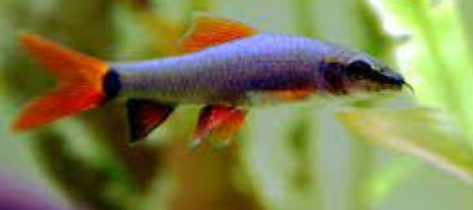
The albino rainbow shark is the complete opposite of the common rainbow shark. Instead of the dark body, the albino rainbow shark is all white (with pinkish undertones) and pale orange or red fins. Although the rarer and more coveted albino rainbow shark will have clear fins.
Glofish rainbow shark
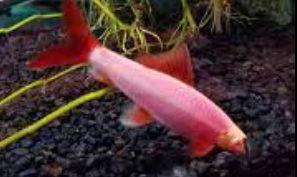
The glofish rainbow shark is an amazing subspecies, although their story could spur controversy. There are no words to describe the majesty of these fish due to their fluorescent colors. They are the result of rainbow sharks having their genes spliced with jellyfish. Initially, there were only two colors available with cosmic names such as galaxy purple (slightly magenta) and sunburst orange.
The best part about it is its natural coloring!
However, glofish rainbow sharks are now available in 2 more colors, blue and green! Since they seem to glow, adding them to your tank with matching plant decoration could yield a neon tank that is even more impressive with a blacklight!
Lifespan Of Rainbow Shark
Typically, the rainbow shark can live anywhere from 5-8 years in captivity. Factors that can contribute to the lifespan of rainbow sharks include proper water conditions, maintenance, and monitoring for diseases.
Rainbow Shark Size
How big do rainbow sharks get? Rainbow sharks can typically get to about 6 inches, but they may be smaller in captivity. How fast do rainbow sharks grow? Rainbow sharks grow quite quickly and can get up to about 1-1.5 inches in the first few weeks, and it will take them a few months at most to grow to their full size.
Color
Typically, the rainbow shark is a dark gray color, almost black, with contrasting orange or red fins (we assume that’s where they get the ruby shark nickname). The gray/black coloration paired with red or orange fins is typical of the common rainbow shark. However, there are a few different kinds.
Rainbow Shark Care Level
Rainbow sharks can be easy to care for since they aren’t susceptible to many diseases. Their care level goes up due to their semi-aggressive nature. However, since they are a freshwater fish, they can be prone to some freshwater diseases such as bloat, ich, swim bladder and even constipation.
Bloat is quite easy to spot as it causes your rainbow sharks to balloon. It may not be too obvious, but bloating in a rainbow shark is similar to bloating in other animals. It’s caused by unpassed gasses and food or even fluids. Other than the obvious change in appearance, your fish may also act differently, such as not being as active as before.
Ich is a skin disease that can be seen across your rainbow shark’s scales and extend to their gills as well. Ich is present in the form of white spots across your rainbow shark. You may see your rainbow sharks start to exhibit odd behavior such as scraping themselves across surfaces. This action may even appear before the white spots, so monitor your rainbow shark closely.
Another issue is swim bladder, which is common among freshwater species. Awkward movement and the inability to swim in the direction they want to go in are common symptoms of swim bladder. You may also see your fish sinking to the bottom of the tank if they are used to being closer to the surface and odd behavior like being unable to keep their balance.
Finally, your rainbow shark may also suffer from constipation, but luckily this issue usually fixes itself. Similar to constipation in other animals, a lack of fiber can be a major contributor. Make sure your rainbow shark gets its fair share of veggies to balance out its diet. All in all, if you watch out for these issues, the rainbow shark is a resilient species that can handle a lot.
Rainbow Shark Temperament and Behavior
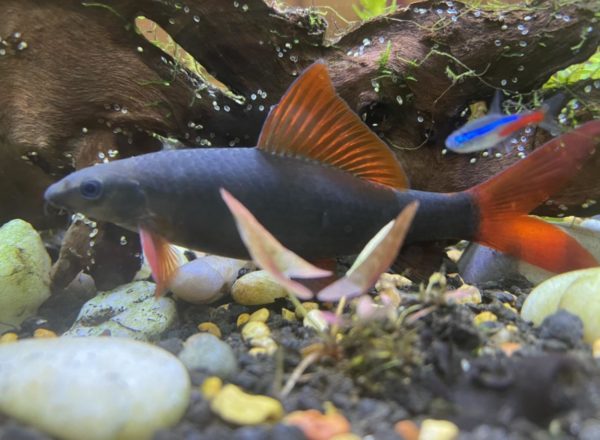
Will rainbow sharks kill other fish? Yes, and no. They are known to be semi-aggressive, and their ill tempers can be triggered if they feel like their territory is being impeded on. They are quite a territorial fish, which could lead to aggression. Other bottom-dwellers could bear the brunt of their feisty personalities. Also, because they tend to live near the bottom of your tank, the rainbow shark can have the same purpose of cleaner fish and crustaceans and eat algae.
Rainbow sharks are active swimmers and without enough space to accommodate them, they may turn their frustration to other fish and even be aggressive towards their own kind. Harmful behavior they exhibit may include fin biting, and head butting.
Do rainbow sharks like to hide? They do! This is why you need to make sure to decorate the tank with dense vegetation among other things. Also, to keep your rainbow shark safe and sound inside the tank, we would suggest an aquarium cover. This fish species have been known to jump, however uncommon, and to prevent them from leaping out of the tank, a cover can curb this behavior.
Family
The rainbow shark is from the cyprinidae family, the same family as minnows and is native to freshwater basins in Southeast Asia.
Rainbow Shark Diet
Being omnivorous, the rainbow shark will require balanced meals of both meat and plants. Their diet in the wild is varied, and includes large amounts of plants, algae, insect larvae and other meat. They are quite easy to feed and aren’t picky. Since they are bottom-dwellers, you would need to feed them food that sinks to the bottom. Pellets are recommended over flake food because they sink better.
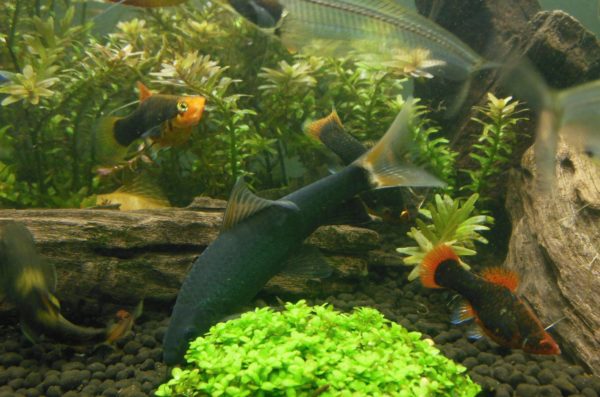
For algae, if they have tank mates then that part is pretty much taken care of. If you would like to add more to the diet, we suggest algae wafers or tablets. As for the carnivorous side of the rainbow shark, focus on brine shrimp and other crustaceans (live brine shrimp will be a treat), zooplankton and insect larvae. You can also supplement their diet with real blanched vegetables from your kitchen including lettuce and spinach.
Their meat diet has a direct impact on their coloration. Giving your rainbow sharks a steady flow of bloodworms will also make sure their coloration stands out. You can give the fry a varied diet right from when they are able to eat bigger food. This will make sure they grow to their full size and to be healthy adults.
They are small creatures that don’t need to eat too much. As a rule of thumb, only feed your rainbow sharks the amount they can consume in a span of 5 min. Clear out all the leftovers to ensure the purity of the water. Spread out their feeding to 2-3 times a day and that should be enough.
Rainbow Shark Tank Conditions
As mentioned, the rainbow shark is used to tropical freshwater and is native to Southeast Asia. The best chance you have at cultivating a healthy tank of rainbow sharks is to mimic their natural environments. Plenty of oxygen and water flow is needed as well. No matter what species you decide to get (even the genetically enhanced glofish sharks) their needs for tank conditions will remain the same.
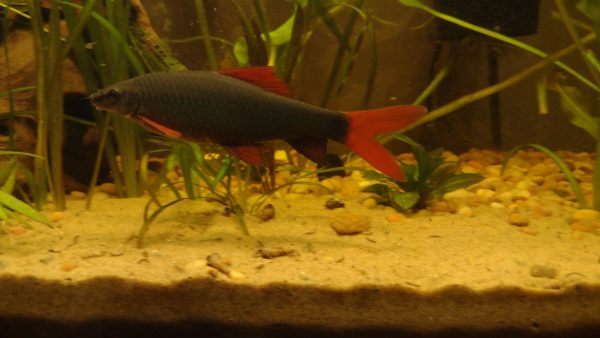
A lot of thick vegetation is also required. Not only do they lessen aggressive behavior by defining territory, but they are great places to hide in and explore for the active rainbow shark. Other decorations to add that can lessen the tension and make their lives more interesting would be driftwood, caves, and rocks.
As for the substrate, anything will do for rainbow sharks. It’s okay to cater to other species in the tank when it comes to the substrate or the plants you plan on keeping.
Some of the best plants for the rainbow shark are the following:
- Java Fern – They are a resilient and tough plant that can thrive in low light conditions. They don’t require a lot of care, fall within the aquarium specs a rainbow shark needs and can create beautiful aquascapes.
- Java Moss – Similar to its cousin, the java fern, the java moss is a tough plant that can span your entire tank.
- Hornwort – Also within the aquarium parameters is the hornwort, a near-indestructible plant that can be simply placed inside your tank.
They don’t have many needs in terms of lighting, so we would just suggest placing the aquarium in a space with access to adequate sunshine.
Rainbow Shark Tank Size and Specifications
Rainbow sharks are very active. They like to explore, hide and use the entirety of the tank. For this reason, even due to their small size, we would recommend a minimum tank size of at least 50 gallons. What’s also different about the rainbow shark is that because they don’t use much of the upper space, you need to make sure the tank is spacious length-wise.
Therefore, you need a longer tank to make sure they have enough space to swim. If your tank isn’t long and is only tall, your rainbow shark could still be lacking the swimming space needed and become aggressive. To lower the risk of aggression, a 60 gallon tank would be a good place to start if your tank isn’t elongated.
Temperature
The rainbow shark is used to tropical waters and needs warmer temperatures between 75°F – 80°F (24°C – 27°C). Depending on where you live, a heater may not be necessary if these parameters in the aquarium can be maintained.
Water Conditions
As for the water, keep it at pH 6.5-7.5, with water hardness at 5-11 dGH. Unfortunately, rainbow sharks are quite sensitive to water changes, which means you will need to change the water every week. Aim for about a quarter of the tanks water to filter out and replace.
Water Parameter
Water Hardness- 5 to 11 DH
pH- 6.5 to 7.5 pH
Water flow rate- Moderate to the fast flow of water will work great
Water temperature- 75 to 81-degree F
Maintenance and Care
To make sure nitrate levels are optimal, oxygen is sufficient and the water is clean, you will need to cycle out about 20-30% of the tanks water every week. Unfortunately, your rainbow sharks will need more tank cycling than other species. So do the math for how many gallons of water need to be cycled out in a 50-60 gallon tank.
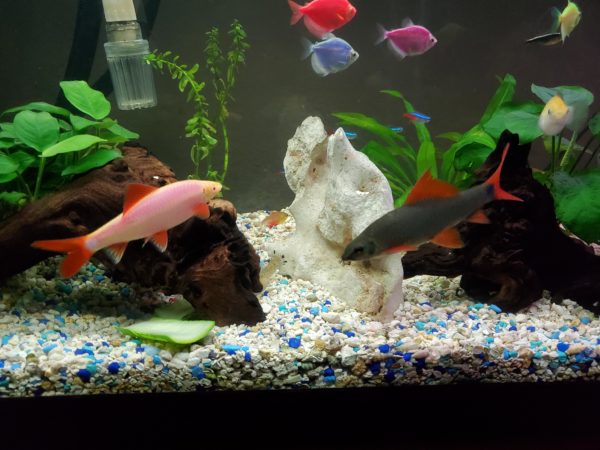
Even if you think the tank looks clean, you may be surprised by how much debris is hidden among the plants and substrate. Once you jostle the aquarium around and move the decorations, you may be shocked by what you see. Due to this, we wouldn’t recommend eyeballing the water conditions and to actually test for it.
An easy way to cycle your 50-60 gallon tank is with a siphon. However, this could be very time-consuming if your tank is larger. This is another easier option, and that is with water change systems that will cycle and drain the water directly into your sink, minimizing the mess.
There are two ways you can deal with the inhabitants of the aquarium. You can either leave them in or take them out. If you decide to go with the siphon, leaving them in could be easier. However, you have to be careful and gentle not to disturb the rainbow shark tank too much.
If you go for the water change system, you need to be extra careful with the smaller fish. You do not want them to be siphoned out with the water and drained into your sink.
If you live in a colder country, investing in a submersible water heater is a good idea. They also would require a proper filter that can keep the water flow moderate and the water clean.
What About The Filtration
Rainbow sharks can thrive well in fast-flowing water. So, you can add a good filtration system to the tank. When there is a better waterflow, you can easily maintain the water quality by effectively filtering the organic wastes. Besides, by adding an external as well as an internal filter, you can increase the aquarium’s water movement.
Rainbow Shark Filter Type
One of the most crucial components of your Rainbow Sharks aquarium is the filtration system responsible for moving and cleaning the water, keeping it safe for your Rainbow Sharks. There are three different types of filtration that you can use for the tank.
Biological Filtration
Biological filtration uses different aquarium plants and bacteria that generally keep the toxic ammonia and nitrogen compounds stable. Beneficial bacteria can generally grow on surfaces like gravel, walls, and more. Some filters have bio-rings and bio-media with a sufficient surface area to offer a place for the beneficial bacteria to live.
Mechanical Filtration
These systems generally use filter socks, filter floss pads, and sponges that can strain different debris from the water, just like your coffee filter. They are designed to collect all the trash, and after a few days, you need to clean the filter media to keep the system working properly.
Chemical Filtration
This system utilizes special resins or activated carbon to easily remove tannins, medications, and other impurities from the tank water. The media will stop absorbing the pollutants once the system turns saturated with the tank’s impurities.
Lighting For Your Rainbow Shark Tank
Well, you don’t need to arrange any special lighting for your Rainbow Sharks. But experts suggest using LED aquarium lights because they are cheap and can last for years. Besides, LED aquarium lights are easily programmable. So, using this, you can offer them natural night or day cycles. Besides, lighting for your fish tank will largely depend on the types of plans you have added to your fish tank. If you have any confusion, then prefer to take the help of an expert for this.
Rainbow Shark Tank Landscape
In general, Rainbow Sharks are territorial fish. So, if you are planning to keep them, then you need to make sure that you have provided sufficient hiding places in the task. For that, you can add some rocks, hollow decorations, caves, plants, and treated driftwood.
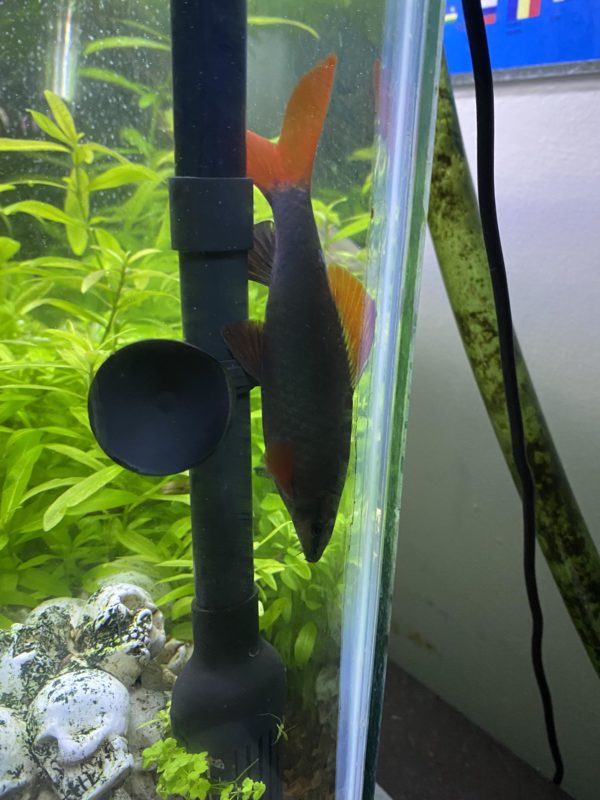
Substrate For The Tank
Remember that the substrate you choose for the tank will greatly impact your fish’s health and your aquarium’s aesthetic look. You must keep four important aspects of any substrate while choosing, i.e., reactivity with the tank water, effect on the fish, color, and particle size.
The substrate will vary in size. Using large substrates will allow more waste and uneaten food to penetrate the substrate, and it can trigger the process of toxic formation if you don’t clean the tank properly. On the other hand, small substrates can create areas that may lack oxygen, and with time, those areas will release hydrogen sulphide that can kill your fish. It is crucial to properly research the particular requirements of your fish while choosing the right substrate size.
On the other hand, the substrate color is a personal preference. While some fish keepers prefer to use bright-colored gravel, some go for the unnatural-looking substrate. One of the major reasons for using colored substrate is to enhance your fish color. If you have a light-colored fish, using a darker-colored substrate can work great and vice-versa.
Type Of Substrates For The Tank
Sand
As per the experts, Rainbow Sharks prefer to live happily in a tank with sand substrates as their native living spaces are lined with sandy bases. Besides, sand is super easy to clean and very rarely collects waste or food.
Gravels
Some aquarists also use gravel. You can also use this but keep in mind that sharper and larger gravels can cause damage to your Rainbow Shark. Besides, if not cleaned regularly, gravel can gather waste and will make your aquarium look dirty. So, if you are planning to use gravel, then don’t forget to clean the fish tank regularly to keep the water condition perfect for your fish.
Your Rainbow Fish may require particular water parameters. For example, the pH level should be under 7.5. One of the most effective ways to increase the pH levels in water is by using substrates that buffer the water, for example, Crushed Coral. Peat moss will create an opposite effect and will lower the pH levels.
Rainbow Shark Compatibility And Tank Mates
As a bonus tip, you should always add more territorial fish into the tank last. If you plan on having a community aquarium, look into the tendencies, temperament and aggression levels of each species. If rainbow sharks are the only aggressive type, then be sure to add them last. This will ensure that they have less of a chance to claim territories and unleash aggression.
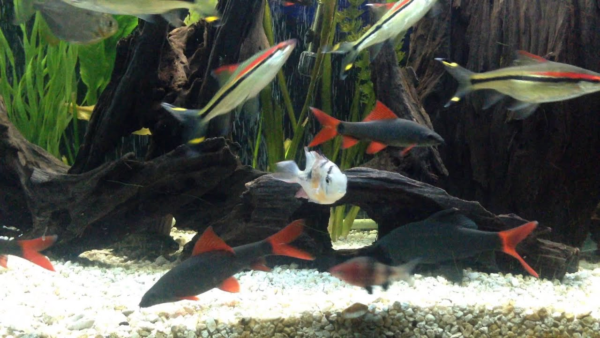
Adding a rainbow shark, who is known to be semi-aggressive to a peaceful community aquarium could disrupt the balance. If you think you can handle it, they are an excellent addition due to their appearance and tank cleaning benefits. We also mentioned before that other bottom-dwellers will most likely bear the brunt of their violent tendencies so you will want to avoid those types of fish (although there have been reports where they get along with minimal issues).
You also should refrain from adding any timid fish, aggressive fish, or ones of a smaller size. Another tendency that is prevalent in many species of fish is that these sharks may lash out at similar-looking fish. Look for aquarium mates that live in the middle or upper levels of the tank, are of a similar size, and can hold their own against the rainbow shark. That doesn’t mean they need to be aggressive, but they do have to be strong.
If you have a female rainbow shark, they are also generally nicer than the males and will exude less aggression. In a tank, we wouldn’t recommend more than 2 rainbow sharks at most. The typical aquarist generally goes for only one, so if you want an easier time in a community aquarium, go for a female.
You also need to consider the needs of all the inhabitants in the tank. If you have more than one species, chances are you will need a larger gallon tank. A rainbow shark tank with only one or two, the water parameters will be easier to grasp. It’s also a good idea to keep a separate tank handy (even if it’s not set up) just so you can separate fish that are being attacked, who are sick, for breeding purposes and cycling of the tank.
Rainbow sharks like a strong current, so you have to be sure that the tank mates you select can tolerate that. Suitable tank mates for the rainbow shark include:
Compatibility
It’s strongly advised for aquarists to have a rainbow shark tank with only one of the species. Rainbow sharks may not even play nice with one of its own. This is normal because even in the wild, the rainbow sharks tend to keep to themselves. You may feel that putting juveniles together in the aquarium turned out fine. That is because the territorial nature of rainbow sharks are not apparent until they mature.
What started out as a happy-go-lucky community aquarium for a pair of rainbow sharks could turn into a very aggressive environment – especially if you have other fish.
Breeding Rainbow Shark
Keeping just one rainbow shark in the tank is easier once you know that they haven’t been successfully bred in the aquarium. Even when they are bred commercially for sale, the help of hormones have been utilized to increase the chances of success. Even with low chances of success, you can still try to breed rainbow sharks if you feel equipped.
In nature, red fin sharks breed during colder seasons, around October to November, but out of season spawning has been recorded as well. They are typical egg layers and the eggs are fertilized by the males after. It only takes about a week for the eggs to hatch.
Around when they hit sexual maturity (about 6 inches in length), you can attempt the breeding process. Since they are aggressive fish, you will need to monitor them well. If you start seeing aggressive behavior, you would need to separate them for a length of time before reintroducing them again. Even if you do manage to create the perfect aquarium environment for rainbow sharks to breed, you may still need to enlist the help of hormones to be successful.
The administration and calculation of at-home hormone dosage can be a bit tricky, but you can get a general idea of what is needed through here.
Make sure you have the following equipment ready for breeding:
- Aquarium (2, one for breeding and one for isolation)
- A pair of rainbow sharks
- Rocks and driftwood
- Live aquarium plants
- Submersible aquarium heater
- Aquarium thermometer
- Peat moss
- Brine shrimp eggs
- Commercial fry food
You will need to decorate a breeding tank specifically for this task. Judging from the size of the rainbow sharks, look into an aquarium that is at least 80 gallons. Make sure that your tank is properly decorated with plenty of caves, plants, driftwood etc., to give them plenty of places to hide and explore. They also need places like caves to be accessible to spawn if you happen to be successful in the breeding.
The water temperature doesn’t need to be changed too much and can remain in the normal range. As for the hardness and pH levels, those don’t need to change too much either. If you see the pH dipping slightly below normal, you can use the peat moss in our equipment list to balance it out.
There isn’t a lot of information about breeding rainbow sharks so they require a lot of monitoring. If you are successful, you need to keep a close eye on the parents after the spawning. Some species of fish will devour their own eggs, and since so little is known about breeding rainbow sharks, we aren’t sure if they will eat their young. If you see the risk of the parents consuming the eggs, then remove them immediately into a separate aquarium.
Once the fry has appeared, they will most likely feed on their yolk sacs. When they have fully consumed them, you will need to start feeding the baby fish. Try to start with algae and baby brine shrimp for a complete diet. Once the juvenile rainbow sharks have become used to these foods, you can later introduce pellets, flakes, blanched vegetables and more.
Breeding Level – Hard
The semi-aggressive streak has made breeding Rainbow Sharks very challenging at home. It has been seen that females and males don’t easily get along and attack each other if you keep them in the same tank. That’s why the commercial Rainbow Sharks breeding industry uses hormone injections for happy spawning.
Rainbow Sharks prefer to lay eggs during October and November, and they wait for specific day lengths or temperatures. As they belong to oviparous species, females lay eggs, and by spraying their milk, males fertilize the eggs. In general, the eggs hatch within a week. Have a look at the below-given information to understand how to breed them successfully.
Rainbow Shark Common Diseases And Their Treatment
As per the experts, these species are quite resilient, and there are not a lot of diseases that are seen to develop again and again. As freshwater species, they can suffer from some common freshwater diseases. However, you don’t have to worry about this as some diseases are curable, and you can avoid them by keeping the fish tank and water clean.
Some common Rainbow Shark diseases are:
Bloat
Bloat certainly doesn’t have to be as severe as the picture, but you get the idea. Bloating is an accumulation of gas, fluids, or unpassed food present in the fish. There is a difference between a fish that has eaten more and a bloated fish. Rainbow Sharks that have eaten too much will behave normally, but others will not.
Some Common Symptoms
- The fish’s stomach will be distended without any raised scales.
- Your fish will develop some signs of discomfort and avoid normal activities and swimming.
- Your fish will not poop properly.
Causes:
- Constipation
- Intestinal blockage
- Internal tumors or growths
- Internal bacterial infection
Itching In Fish
Itching is generally caused by different parasites and appears like small white marks or pimples on the fish’s body. It can attach to gills, bodies, fins, or mouths. When your Rainbow Sharks have this issue, you can see them scraping against trees, substrates, and other objects in the aquarium.
Some Common Symptoms To Consider:
- Scratching
- White spots
- Bloody streaks or redness
Causes:
- Parasite- Ichthyophthirius Multifiliis
Constipation
Well, in general, constipation usually gets cleared up on its own. However, sometimes, you can treat the condition by feeding a blanched fish diet. For carnivores or omnivores, daphnia or brine shrimp can work great. These are quick, painless fixes for your fish. Sometimes, the experts may suggest you carry out a salt bath.
Common Symptoms To Consider
- Bloating
- White and stringy faeces
- Lethargy
Causes:
- Lack of fiber in the diet
- HITH- Hexamita
There are different types of antibiotics that you can use to treat most health issues. However, only use the safe antibiotics for minnows and species that belong to the Cyprinidae family. For example, Prazipro.
You should use anything that contains dyes, salt, copper, and other harmful things. Don’t use Paraguard. It comes with Malachite Green, which can trigger more health issues among the Rainbow Sharks.
While treating your Rainbow Shark, keep the affected fish in a quarantine box to prevent the spread of diseases or infections to other tankmates.
Facts About Rainbow Sharks
- These species are quite popular due to their attractive colors. The body of a Rainbow Shark can be in yellow, pick, or back color. The light-colored body contrasts with the dark-colored fins to create a unique appearance.
- Rainbow Sharks are omnivorous. That means they can eat meat and a plant that generally sits on the bottom of the tank.
- Rainbow Sharks will be a perfect option when buying some of the most popular aquarium fishes for your fish tank.
- Even though these species are not generally bred in aquariums, they are widely bred on commercial farms.
- Rainbow Sharks love to live in freshwater, and they are generally found in Southeast Asia’s freshwater bodies, especially the Albino Rainbow Sharks. They prefer to live in flowing water bodies, for example, streams and rivers, and you can also find them near sandy bases.
- They are semi-aggressive species. As per some studies, when a proper living environment is provided, they can live in a group. If you plan to bring Rainbow Sharks, you should add more similar species into the tank. A single fish may feel lonely and will also stress out very soon.
- These species can live around 5 to 8 years when a proper living environment is provided. Both in captivity and wild, they can live up to eight years. To keep your Rainbow Shark happy, add more rainbow sharks to the tank as their tank mates.
- As per some Rainbow Shark keepers, these species can grow up to 10 to 12 inches.
- Keeping more than one Rainbow Fish in your fish tawhichead to aggression between two Rainbow Sharks. So, don’t keep, just don’t shark. But you can keep a group of five as one can act as a leader. Other fishes will follow the leader.
- As per the IUCN Red List, these sharks come under the Least Concern conservation category. As per some studies, Rainbow Sharks inhabit South-eastern Asia in a huge number, and they are thriving well.
- They can’t communicate through vocalization; they generally use their body language or signs to convey their thoughts. They come with an organ that can easily detect even a tiny disturbance in the water.
Are Rainbow Sharks Right For You?
As discussed above, rainbow sharks always demonstrate territorial behavior. And looking at this fact, it is advisable not to get a Rainbow Shark unless you have a large tank with sufficient swimming space and peaceful tank mates.
As per the experts, if you are a beginner aquarist and searching for a low-maintenance and calm fish for your fish tank, then buying a Rainbow Shark will not be a good option.There is no doubt that Rainbow Sharks are very active and beautiful fish. Besides, they are easy to care for when you house them with the right type of tank mates. They may sometimes show aggressive behaviors, but these are very entertaining to watch in the fish tank. So, if you think you can take good care of your Rainbow Shark and understand the fish care tips and tank setup requirements mentioned here, then go on and get this fish now.
Faqs
How To Identify A Male And Female Rainbow Shark?
As per the experts, one can tell if the Rainbow Sharks are males or females by looking at the body coloring and shape. If you look carefully, you will find that female sharks are a little bigger and thicker in size than male Rainbow Sharks. On the other hand, males come with slightly brighter colors than females.
What’s more?
You can see a black-lines on the tails and anal fins, which are not there in the females. It may be noted that identifying between a male or female rainbow shark once it sexually matures will be much easier than when they are very young. As per the studies, they generally reach their sexual maturity at around 2 years old.
Is It Possible To Keep A Rainbow Shark In A 10-Gallon Fish Tank?
No, it is not advisable to keep a rainbow shark in a small tank or around a 10-gallon tank. Experienced aquarists have regarded rainbow sharks as species that love to live in a place that can offer a lot of swimming space. The ideal tank size for keeping your rainbow shark happy and stress-free is around a 50-gallon tank.
It has been seen that when kept in a smaller aquarium, rainbow sharks become more aggressive and stressed. These species are territorial by nature; they always look for more spaces to live and feel comfortable. Besides, they also need a lot of horizontal space to swim. So, if you are planning to keep a Rainbow Shark, you should get a long tank instead of a tall one. We suggest you go for an 18-inch wide and 4-feet long tank. And if you want to add more fish to the tank, you will need a bigger tank.
My Rainbow Shark Is Turning White. Why?
One of the major reasons why your shark is turning white is stress. Most species lost their color due to stress, not just the Rainbow Sharks. Talking about some possible factors that can lead to stress in Rainbow Sharks are; incorrect diet, lack of space, wrong chemical levels, incorrect water temperatures, lack of space, incorrect water pH, and different parasites or illnesses. So, if you think your Rainbow Shark is turning white, then observe for other symptoms, for example, lack of appetite and fatigue. Besides, don’t forget to check the water condition. If you have any doubt, it would be better to consult an expert.
My Rainbow Sharks Are Hiding. Why?
Rainbow Sharks normally claim their territories by hiding. As territorial species, they generally love to stake claims on tunnels, caves, and other available hiding spots in the aquarium by resting in those places.
On the other hand, newly-added sharks into the tank may prefer to hide as they are confident about their new living space.
However, when they feel more comfortable and safer, they will swim around. Remember that, hiding a normal behavior for your Rainbow Sharks, so don’t worry about it.
However, if it has been more than 5 to 7 days and your fish is not coming out from the hiding spot, you should check the water condition of the tanka and observe the fish for any illness.
Do They Jump Out Of The Aquarium?
Yes, they normally jump out of the aquarium. Rainbow Sharks are bottom-dwellers, but sometimes they can act notoriously and then jump out of the tank. This is normal among these species. But sometimes, poor water quality or stress can be some reasons. As the tank is large, even after jumping out, they’re likely to land in the same tank. But if they don’t land back in the water, they will get injured. So, it is advisable to use a cover for your tank to keep them safe.
Conclusion
Are rainbow sharks suitable for your tank? If you are looking into starting a tank with just rainbow sharks, then the work is easy. All you need to do is be sure you have the proper-sized tank, the right substrate and water conditions to keep them well and healthy. If you have other fish in the aquarium, then you will have to consider not adding other fish after the addition of the rainbow sharks.
As a rule of thumb, rainbow sharks should be added last to any fish tank. This will minimize territorial tendencies and attacks. Complete the tank setup with plenty of places for your fish to explore and provide densely planted vegetation to mark territories.
Since the rainbow shark is a bottom-dwelling fish, the food you feed needs to reflect that fact and sink to the bottom. They aren’t picky eaters so as long as you balance their omnivorous diet, they will do well in captivity. These fish can get along well with slightly larger fish with strong personalities. They don’t need to be aggressive, but they should be able to handle an aggressive rainbow shark.
To be sure your fish are happy and well, we would suggest constant monitoring to rule out any common freshwater fish diseases such as ich and swim bladder. All in all, the rainbow shark is an amazing and exotic fish to add to your tank.
No related posts.

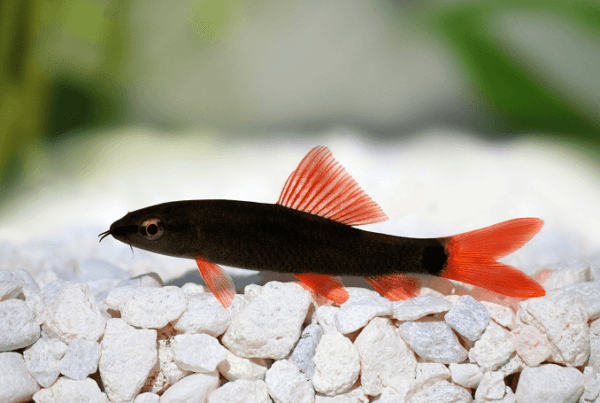
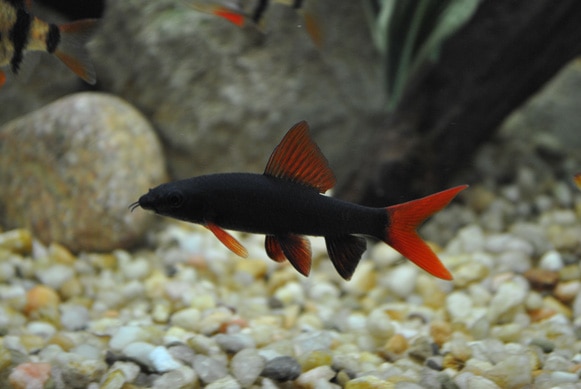
1 thought on “Rainbow Shark Care Guide: Tank Setup, Diet, Breeding, And More”
Hi Adam, is there a treatment if a Rainbow shark gets Ich? Thank you.